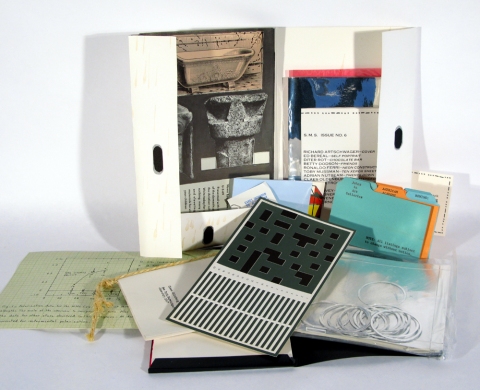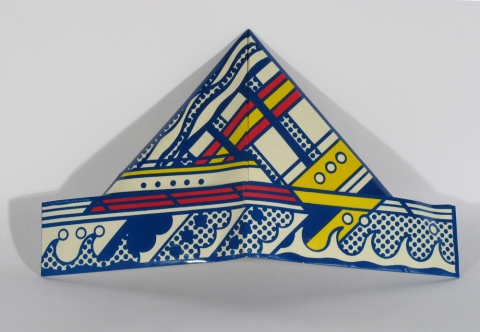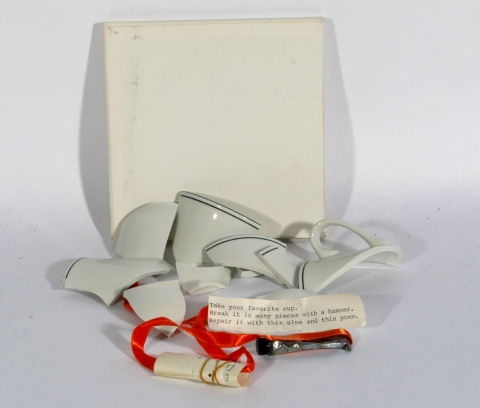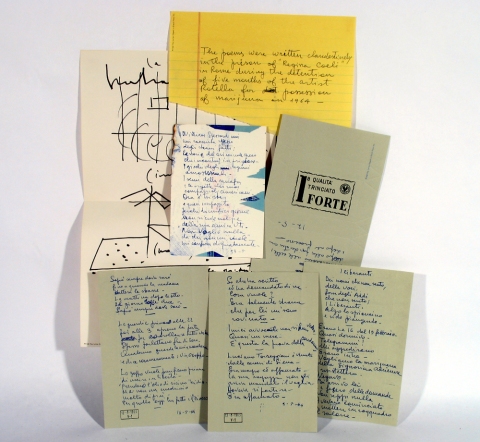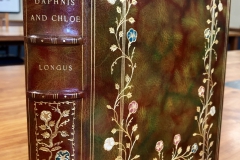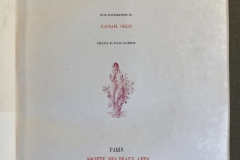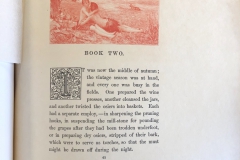

Eyes that see, persons with knowledge, they must be allowed to construct the new world. — Le Corbusier, When the Cathedrals Were White.1
This exhibition celebrates a series of color photographs of the Vassar College Art Library, arguably the first modern interior in the United States on an academic campus, restored in 2007- 2008 by a New York based firm known for its conscientious restoration of important historic landmarks, Platt, Byard, Dovell, White. Andrew Tallon, who taught the History of Art at Vassar College from 2007 until his untimely death in 2018, took the photographs in the summer of 2016 to illustrate a monograph on John McAndrew, the scholar-architect responsible for the library’s original 1937 design. This monograph took shape around a scholarly study of McAndrew’s modernism written by the architectural historian Mardges Bacon.2
Preservation and its historical objective is a project of the future as well as the past. The restorers of John McAndrew’s Art Library understood this implicitly. One of the two architects on the project, the late Paul Spencer Byard, stated this principle as follows:
There is in a sense no such thing as “preservation”…. Every act of preservation is inescapably an act of renewal by the light of a later time. 3
Even what we know as the modern demands this historical treatment. It cannot not be envisioned without it. Every new work involves temporal exchange, because, as Byard points out:
Each new work of art is supported and enriched by its sources and its cultural and physical contexts. . . . In each creative act the old and the new are inextricably entwined and inescapably beholden to each other. 4

In a word, the new depends on the old for its existence, even as the old requires the new for its apprehension. Acts of historical enquiry and historic preservation are therefore not mere acts of nostalgia; they derive their energy from our urgency to creatively envision solutions to the confrontations of the present and future in juxtaposition to what has gone before. The instrument of the photograph, so relentless in showing us a present that slips into the past as soon as the shutter is snapped, thus shows us in the same moment the past as it enters and builds itself into the present.
Andrew Tallon’s deep familiarity with Gothic architecture made him cognizant of the dialectic of old and new even in the practices of medieval builders. During his initial visit to Vassar he lectured on successive medieval renovations to particular buttresses of Notre Dame of Paris, each buttress building on observations about the strengths and weaknesses of the earlier designs.
Superb historian and photographer that he was, it comes as nosurprise to us that Andrew Tallon’s photography of a quintessentially modernist architectural space envisions this space as both an artifact of a bygone era of design (“modernism”) and a creative field that holds the promise of a future with endless potential. No less “historic” than the Gothic structures Tallon was so skilled at documenting, these photographs of John McAndrew’s own vision of the space of the future, a space whose restoration was based on both photographic records and scientific research, illuminate the pure form within which the future of art and architectural history at Vassar unfolds. For McAndrew, the modernist revolution was in color. An essential design element that Tallon’s photographs hone in on are the color schemes, which McAndrew modeled on Le Corbusier’s purist color palette and his own insight that color could be deployed in the design of a study space in order to offset illustrative materials as well as maximize illumination. 5 The colors were thus meant to subdivide these materials and give the eye one wall at a time to consume so that, in the words of a contemporary member of the art department, the color effect would thus reduce “the inevitable fatigue of the very powers of attention we try to evoke.” 6
While preservation is not a matter of fixing past forms in amber, a certain attentive regard for these forms which comes through study and understanding will lead to a willingness to spend time with and engage them. Imagination cannot exist without memory any more than memory can exist without imagination. So it is no coincidence that so many of the individuals who have created and recreated the beautiful and functional learning space documented in Andrew’s photographs should be known for their work in historic preservation. This includes John McAndrew himself, who late in his career helped to found the Save Venice organization after the 1966 flood. Paul S. Byard and Charles A. Platt have worked as architects on projects to preserve major New York monuments including Carnegie Hall, the Cooper Union Foundation Building, the New York Historical Society, and the Park Avenue Armory. They have also directed or served on the boards of the New York Landmarks Conservancy and the Municipal Art Society, and Paul Byard’s legal background was instrumental in the Supreme Court case that saved Grand Central Terminal. As educators, both men helped to formulate, and taught in, the the historic preservation studio architecture program at Columbia University. Andrew Tallon was a founder of the Friends of Notre-Dame de Paris, an organization established to collect funds for the maintenance and restoration of the great cathedral that was a chief object of his research. In recent months that research has become an international media story as it becomes apparent that it will be critical to the effort to restore the cathedral after the catastrophic fire of April 15.

Architectural historians in Vassar’s Art Department have been scholars rooted in medieval and Renaissance studies who taught and wrote about contemporary design. In addition to his work as an architect, McAndrew, an expert in Venetian architecture, made an immense contribution in a series of exhibitions he organized as curator of Architecture at the Museum of Modern Art. These exhibitions shaped public opinion during the critical period when European modernism was being introduced to North America. His successors over the following 80 years at Vassar College, Richard Krautheimer, John Coolidge, Wolfgang Lotz, Richard Pommer, and Nicholas Adams, were historical specialists as well as participants, through teaching and scholarship, in the architecture of their own times: past and present infused one another in their work.

Le Corbusier’s “persons with knowledge” who have “eyes that see,” to whom the future should be entrusted, are endowed with the ability to construct a new world out of the old. Like John McAndrew, an educator who used his architectural talent to create a new kind of learning space for students, Andrew Tallon was known at Vassar from the day he arrived as an innovator in methodologies for visualizing and communicating architectural forms and ideas, particularly with digital media. Arriving in the Art Department just as digital images were taking the place of 35mm slides, Tallon was instrumental in the Department’s acquisition of state-of-the-art digital projection equipment for its classrooms that made the use of digital images for teaching truly viable, and he led a fundamental change in the way visual information is communicated in teaching. His groundbreaking exhibition at the Frances Lehman Loeb Art Center in 2012, Space, Time, and Narrative: Mapping Gothic France, presented the museum-going public with a demonstration of the potential of new media to alter space, and succeeded at something all architectural exhibits strive for but rarely achieve, a sensory experience in a museum setting of the physical spaces these exhibits purport to represent. Employing phased, overlapping digital images and high-resolution projectors, the exhibition truly transformed the space of the museum into something other than what we knew it as, and evoked in a stunning way a visual and visceral sense of the dramatic light-and-color-filled Gothic interiors with which Andrew was so familiar. Andrew’s Tallon’s vision was informed by deep historical understanding, drew on his creative talents as an experimenter with new media, and was employed self-reflexively to create new spaces for teaching and learning. In these photographs he draws our attention to table tops, natural light, color, and stairways that form the passages of the process of study. The photographs appear as material emblems of this process, of the virtuous circle of recollection and experiment, of the conversation that takes place between the document and the work of art, that is recreated by the seeing eyes of all the scholars and artists, past and future, who pass through our portals who are our, and his, enduring legacy.
—Thomas Hill, April 2019
Notes:
1. (New York: Reynal & Hitchcock, 1947), 5.
2. Bacon, Mardges. John McAndrew’s Modernist Vision: From the Vassar College Art Library to the Museum of Modern Art in New York (Princeton Architectural Press, 2018).
3. Byard, Paul Spencer, The Architecture of Additions (New York:
Norton, 1998), 182.
4. Byard, 17.
5. Bacon, 55-102.
6. Agnes Claflin, “The Art Department in New Quarters,” Vassar Alumnae Magazine, Vol. 23, no. 6 (July 1, 1938) reproduced in Bacon, 10.








